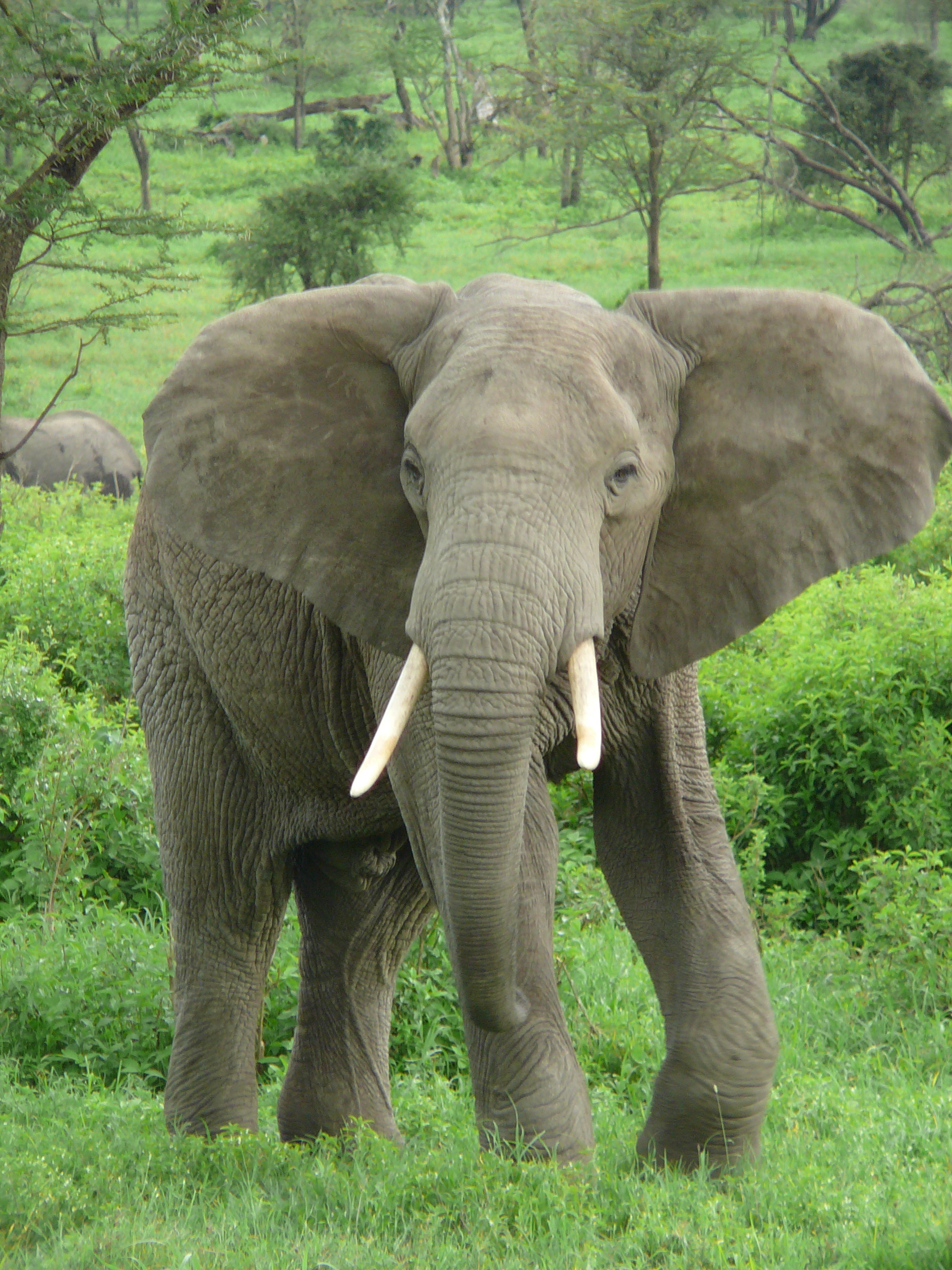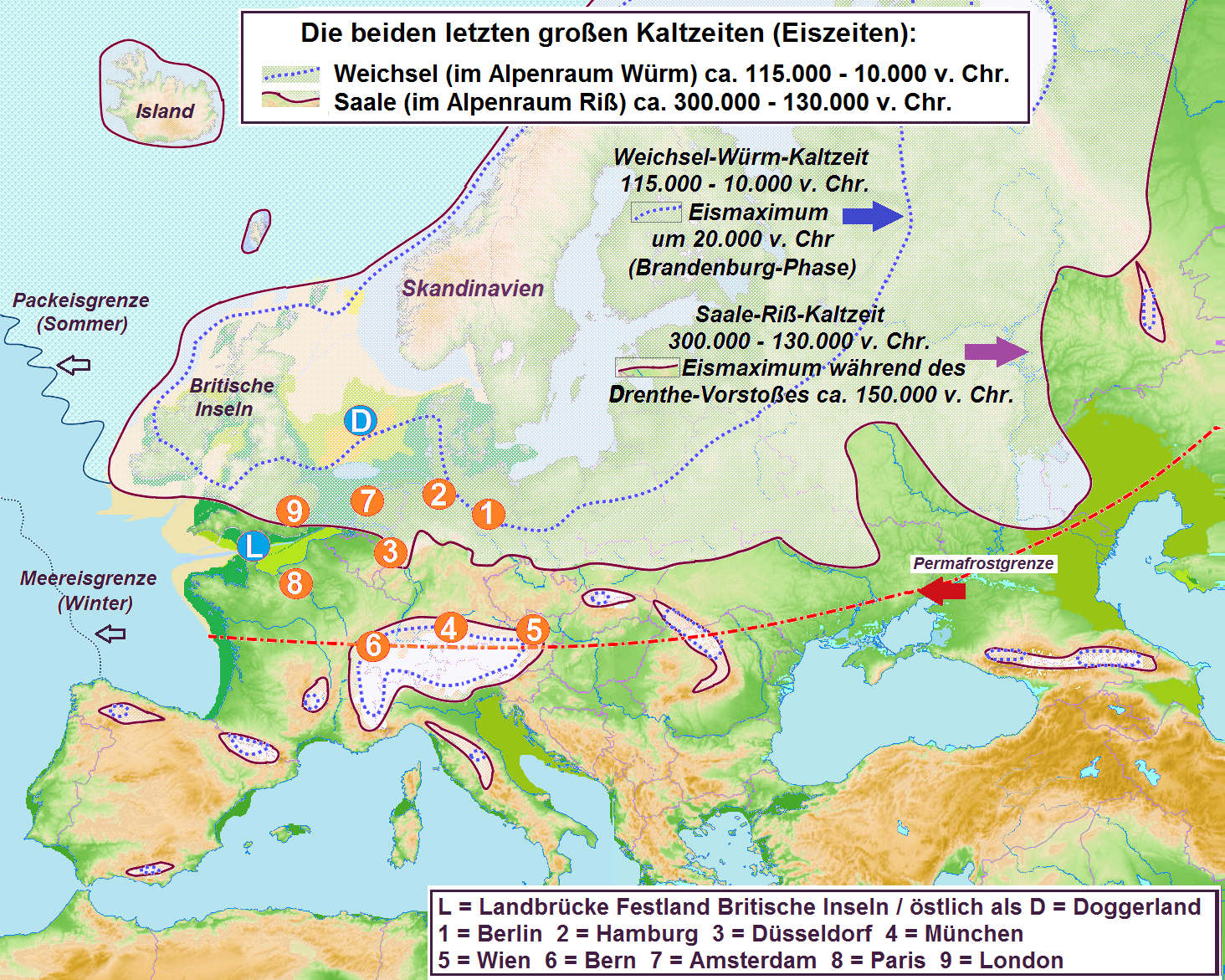|
Late Pleistocene
The Late Pleistocene is an unofficial Age (geology), age in the international geologic timescale in chronostratigraphy, also known as Upper Pleistocene from a Stratigraphy, stratigraphic perspective. It is intended to be the fourth division of the Pleistocene Epoch within the ongoing Quaternary Period. It is currently defined as the time between c. 129,000 and c. 11,700 years ago. The Late Pleistocene equates to the proposed Tarantian Age of the geologic time scale, preceded by the officially ratified Chibanian (formerly known as Middle Pleistocene) and succeeded by the officially ratified Greenlandian. The estimated beginning of the Tarantian is the start of the Eemian interglacial period (Marine Isotope Stage 5). It is held to end with the termination of the Younger Dryas, some 10th millennium BC, 11,700 years ago when the Holocene Epoch began. The term Upper Pleistocene is currently in use as a provisional or "quasi-formal" designation by the International Union of Geological ... [...More Info...] [...Related Items...] OR: [Wikipedia] [Google] [Baidu] |
International Commission On Stratigraphy
The International Commission on Stratigraphy (ICS), sometimes referred to unofficially as the "International Stratigraphic Commission", is a daughter or major subcommittee grade scientific daughter organization that concerns itself with stratigraphy, stratigraphical, geology, geological, and chronology, geochronological matters on a global scale. It is the largest subordinate body of the International Union of Geological Sciences (IUGS). The ICS is essentially a permanent working committee, working subcommittee, which meets far more regularly than the quadrennial meetings scheduled by the IUGS, when it meets as a congress or committee, membership of the whole. Aims One of its main aims, a project begun in 1974, is to establish a multidisciplinary standard and global geologic time scale that will ease paleontology, paleontological and geobiology, geobiological comparisons region to region by benchmarks with stringent and rigorous strata criteria called Global Boundary Stratotype ... [...More Info...] [...Related Items...] OR: [Wikipedia] [Google] [Baidu] |
10th Millennium BC
The 10th millennium BC spanned the years 10,000 BC to 9001 BC (c. 12 ka to c. 11 ka). It marks the beginning of the transition from the Palaeolithic to the Neolithic via the interim Mesolithic ( Northern Europe and Western Europe) and Epipaleolithic (Levant and Near East) periods, which together form the first part of the Holocene epoch that is generally believed to have begun c. 9700 BC (c. 11.7 ka) and is the current geological epoch. It is impossible to precisely date events that happened around the time of this millennium, and all dates mentioned here are estimates mostly based on geological, anthropological analysis, and radiometric dating. Holocene epoch The main characteristic of the Holocene has been the worldwide abundance of ''Homo sapiens sapiens'' (humankind). The epoch began in the wake of the Würm glaciation, generally known as the Last Ice Age, which began 109 ka and ended 14 ka when ''Homo sapiens sapiens'' was in the Palaeolithic (Old Stone) Age. Followi ... [...More Info...] [...Related Items...] OR: [Wikipedia] [Google] [Baidu] |
Archaic Human
A number of varieties of ''Homo'' are grouped into the broad category of archaic humans in the period that precedes and is contemporary to the emergence of the earliest early modern humans (''Homo sapiens'') around 300 ka. Omo-Kibish I (Omo I) from southern Ethiopia ( 195 or 233 ka), the remains from Jebel Irhoud in Morocco (about 315 ka) and Florisbad in South Africa (259 ka) are among the earliest remains of ''Homo sapiens''. The term typically includes ''Homo neanderthalensis'' (430 ± 25 ka), Denisovans, ''Homo rhodesiensis'' (300–125 ka), ''Homo heidelbergensis'' (600–200 ka), ''Homo naledi'', ''Homo ergaster'', ''Homo antecessor'', and ''Homo habilis''. There is no universal consensus on this terminology, and varieties of "archaic humans" are included under the binomial name of either ''Homo sapiens'' or ''Homo erectus'' by some authors. Archaic humans had a brain size averaging 1,200 to 1,400 cubic centimeters, which overlaps with the range of modern h ... [...More Info...] [...Related Items...] OR: [Wikipedia] [Google] [Baidu] |
Early Human Migrations
Early human migrations are the earliest migrations and expansions of archaic and modern humans across continents. They are believed to have begun approximately 2 million years ago with the early expansions out of Africa by '' Homo erectus''. This initial migration was followed by other archaic humans including '' H. heidelbergensis'', which lived around 500,000 years ago and was the likely ancestor of Denisovans and Neanderthals as well as modern humans. Early hominids had likely crossed land bridges that have now sunk. Within Africa, '' Homo sapiens'' dispersed around the time of its speciation, roughly 300,000 years ago. The recent African origin paradigm suggests that the anatomically modern humans outside of Africa descend from a population of ''Homo sapiens'' migrating from East Africa roughly 70–50,000 years ago and spreading along the southern coast of Asia and to Oceania by about 50,000 years ago. Modern humans spread across Europe about 40,000 years ago. ... [...More Info...] [...Related Items...] OR: [Wikipedia] [Google] [Baidu] |
Upper Palaeolithic
The Upper Paleolithic (or Upper Palaeolithic) is the third and last subdivision of the Paleolithic or Old Stone Age. Very broadly, it dates to between 50,000 and 12,000 years ago (the beginning of the Holocene), according to some theories coinciding with the appearance of behavioral modernity in early modern humans, until the advent of the Neolithic Revolution and agriculture. Anatomically modern humans (i.e. ''Homo sapiens'') are believed to have emerged in Africa around 300,000 years ago, it has been argued by some that their ways of life changed relatively little from that of archaic humans of the Middle Paleolithic, until about 50,000 years ago, when there was a marked increase in the diversity of artefacts found associated with modern human remains. This period coincides with the most common date assigned to expansion of modern humans from Africa throughout Asia and Eurasia, which contributed to the extinction of the Neanderthals. The Upper Paleolithic has the earlie ... [...More Info...] [...Related Items...] OR: [Wikipedia] [Google] [Baidu] |
Palaeoanthropology
Paleoanthropology or paleo-anthropology is a branch of paleontology and biological anthropology, anthropology which seeks to understand the early development of anatomically modern humans, a process known as wikt:hominization, hominization, through the reconstruction of evolutionary kinship lines within the family Hominidae, working from biological evidence (such as petrified skeletal remains, fossil, bone fragments, footprints) and cultural evidence (such as stone tools, artifacts, and settlement localities). The field draws from and combines primatology, paleontology, biological anthropology, and cultural anthropology. As technologies and methods advance, genetics plays an ever-increasing role, in particular to examine and compare DNA structure as a vital tool of research of the evolutionary kinship lines of related species and genera. Etymology The term paleoanthropology derives from Greek palaiós (παλαιός) "old, ancient", ánthrōpos (ἄνθρωπος) "man, human" an ... [...More Info...] [...Related Items...] OR: [Wikipedia] [Google] [Baidu] |
Quaternary Extinction Event
The Quaternary period (from 2.588 ± 0.005 million years ago to the present) has seen the extinctions of numerous predominantly megafaunal species, which have resulted in a collapse in faunal density and diversity and the extinction of key ecological strata across the globe. The most prominent event in the Late Pleistocene is differentiated from previous Quaternary pulse extinctions by the widespread absence of ecological succession to replace these extinct species, and the regime shift of previously established faunal relationships and habitats as a consequence. The earliest casualties were incurred at 130,000 BCE (the start of the Late Pleistocene), in Australia ~ 60,000 years ago, in Americas ~ 15,000 years ago, coinciding in time with the early human migrations. However, the great majority of extinctions in Afro-Eurasia and the Americas occurred during the transition from the Pleistocene to the Holocene epoch (13,000 BCE to 8,000 BCE). This extinction wave di ... [...More Info...] [...Related Items...] OR: [Wikipedia] [Google] [Baidu] |
Megafauna
In terrestrial zoology, the megafauna (from Greek μέγας ''megas'' "large" and New Latin ''fauna'' "animal life") comprises the large or giant animals of an area, habitat, or geological period, extinct and/or extant. The most common thresholds used are weight over see page 17 (i.e., having a mass comparable to or larger than a human) or over a tonne, (i.e., having a mass comparable to or larger than an ox). The first of these include many species not popularly thought of as overly large, and being the only few large animals left in a given range/area, such as white-tailed deer, Thomson's gazelle, and red kangaroo. In practice, the most common usage encountered in academic and popular writing describes land mammals roughly larger than a human that are not (solely) domesticated. The term is especially associated with the Pleistocene megafauna – the land animals often larger than their extant counterparts that are considered archetypical of the last ice age, such as mammoth ... [...More Info...] [...Related Items...] OR: [Wikipedia] [Google] [Baidu] |
Alps
The Alps () ; german: Alpen ; it, Alpi ; rm, Alps ; sl, Alpe . are the highest and most extensive mountain range system that lies entirely in Europe, stretching approximately across seven Alpine countries (from west to east): France, Switzerland, Italy, Liechtenstein, Austria, Germany, and Slovenia. The Alpine arch generally extends from Nice on the western Mediterranean to Trieste on the Adriatic and Vienna at the beginning of the Pannonian Basin. The mountains were formed over tens of millions of years as the African and Eurasian tectonic plates collided. Extreme shortening caused by the event resulted in marine sedimentary rocks rising by thrusting and folding into high mountain peaks such as Mont Blanc and the Matterhorn. Mont Blanc spans the French–Italian border, and at is the highest mountain in the Alps. The Alpine region area contains 128 peaks higher than . The altitude and size of the range affect the climate in Europe; in the mountains, precipitation ... [...More Info...] [...Related Items...] OR: [Wikipedia] [Google] [Baidu] |
Würm Glaciation
The Würm glaciation or Würm stage (german: Würm-Kaltzeit or ''Würm-Glazial'', colloquially often also ''Würmeiszeit'' or ''Würmzeit''; cf. ice age), usually referred to in the literature as the Würm (often spelled "Wurm"), was the last glacial period in the Alpine region. It is the youngest of the major glaciations of the region that extended beyond the Alps themselves. Like most of the other ice ages of the Pleistocene epoch, it is named after a river, in this case the Würm in Bavaria, a tributary of the Amper. The Würm ice age can be dated to about 115,000 to 11,700 years ago, but sources differ about the dates, depending on whether the long transition phases between the glacials and interglacials (warmer periods) are allocated to one or other of those periods. The average annual temperatures during the Würm ice age in the Alpine Foreland were below −3 °C (today +7 °C). That has been determined from changes in the vegetation (pollen analysis), as well a ... [...More Info...] [...Related Items...] OR: [Wikipedia] [Google] [Baidu] |
Anthropocene
The Anthropocene ( ) is a proposed geological epoch dating from the commencement of significant human impact on Earth's geology and ecosystems, including, but not limited to, anthropogenic climate change. , neither the International Commission on Stratigraphy (ICS) nor the International Union of Geological Sciences (IUGS) has officially approved the term as a recognised subdivision of geologic time, although the Anthropocene Working Group (AWG) of the Subcommission on Quaternary Stratigraphy (SQS) of the ICS voted in April 2016 to proceed towards a formal golden spike (GSSP) proposal to define the Anthropocene epoch in the geologic time scale (GTS) and presented the recommendation to the International Geological Congress in August 2016. In May 2019, the AWG voted in favour of submitting a formal proposal to the ICS by 2021, locating potential stratigraphic markers to the mid-twentieth century of the common era. This time period coincides with the start of the Great Acce ... [...More Info...] [...Related Items...] OR: [Wikipedia] [Google] [Baidu] |
Calabrian (stage)
Calabrian is a subdivision of the Pleistocene Epoch of the geologic time scale, defined as 1.8 Ma—774,000 years ago ± 5,000 years, a period of ~. The end of the stage is defined by the last magnetic pole reversal (781 ± 5 Ka) and plunge into an ice age and global drying possibly colder and drier than the late Miocene ( Messinian) through early Pliocene (Zanclean) cold period. Originally the Calabrian was a European faunal stage primarily based on mollusk fossils. It has become the second geologic age in the Early Pleistocene. Many of the mammalian faunal assemblages of the Early Pleistocene start in the Gelasian. For example, the Platygonus and other Blancan fauna appear first in the Gelasian. History of the definition of the Calabrian Because sea shells are much more abundant as fossils, 19th- and early-20th-century geo-scientists used the plentiful and well-differentiatable Mollusca (mollusks) and Brachiopods to identify stratigraphic boundaries. Thus the Calabrian was ... [...More Info...] [...Related Items...] OR: [Wikipedia] [Google] [Baidu] |


.jpg)







